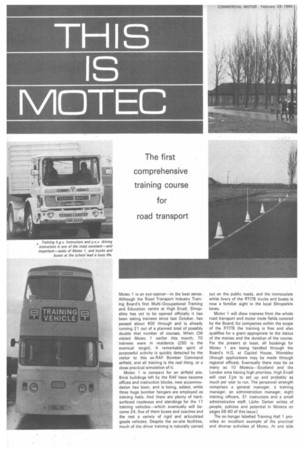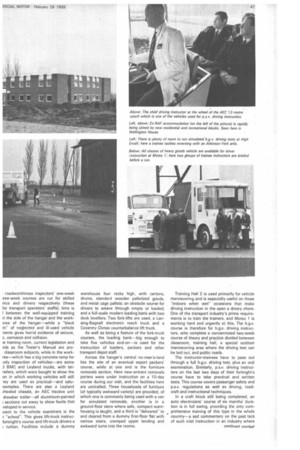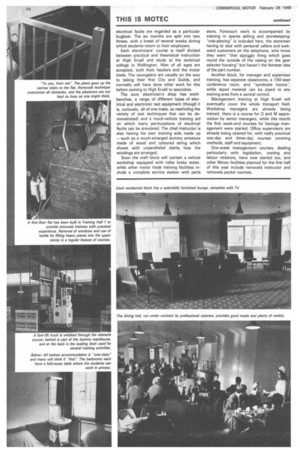TH MOTEC
Page 48

Page 49

Page 50

If you've noticed an error in this article please click here to report it so we can fix it.
The first comprehensive training course for road transport
Motec 1 is an eye-opener—in the best sense. Although the Road Transport Industry Training Board's first Multi-Occupational Training and Education centre at High Ercall, Shropshire has yet to be opened officially it has been taking trainees since last October, has passed about 400 through and is already running 21 out of a planned total of possibly double that number of courses. When, CM visited Motec 1 earlier this month, 70 trainees were in residence (250 is the eventual target). A remarkable spirit of purposeful activity is quickly detected by the visitor to this ex-RAF Bomber Command airfield, and all training is the real thing, or a close practical simulation of it.
Mateo 1 is compact for an airfield site. Brick buildings left by the RAF have become offices and instruction blocks, new accommodation has been, and is being, added, while three huge bomber hangars are employed as training halls. And there are plenty of hardsurfaced roadways and standings for the 17 training vehicles--which eventually will become 24, five of them buses and coaches and the rest a variety of rigid and articulated goods vehicles. Despite the on-site facilities, much of the driver training is naturally carried Out on the public roads, and the immaculate white livery of the RTITB trucks and buses is now a familiar sight in the local Shropshire lanes.
Motec 1 will draw trainees from the whole road transport and motor trade fields covered by the Board; for companies within the scope of the RTITB the training is free and also qualifies for a grant appropriate to the status of the trainee and the duration of the course. For the present at least, all bookings for Mateo 1 are being handled through the Board's H.Q. at Capitol House, Wembley (though applications may be made through regional offices). Eventually there may be as many as 10 Motecs—Scotland and the London area having high priorities. High Ercall will cost f+rn to set up and probably as much per year to run. The personnel strength comprises a general manager, a training manager, an administration manager, eight training officers, 31 instructors and a small administrative staff. (John Darker writes of ,people, policies and potential in Motecs on pages 59-60 of this issue.) The ex-hangar labelled Training Hall 1 provides an excellent example of the practical and diverse activities of Mateo. At one side
roadworthiness inspectors' one-week iree-week courses are run for skilled nics and drivers respectively (these for transport operators' staffs); time is I between the well-equipped training it the side of the hangar and the work3rea of the hangar—while a "black m" of neglected and ill-used vehicle nents gives horrid evidence of seizure, a, corrosion and collision,
ie training room, current legislation and lids as the Tester's Manual are Oroclassroom subjects, while in the workrea—which has a big concrete ramp for ody inspection of vehicles—are some d BMC and Leyland trucks, with tatrailers, which were bought to show the on in which working vehicles will still ley are used as practical—and salumamples. There are also a Leyland /heeled chassis, an AEC tractive unit drawbar trailer—ail aluminium-painted sections cut away to show faults that veloped in service.
icent to the vehicle examiners is the t "school". This gives lift-truck instrucfortnight's course and lift-truck drivers a tuition. Facilities include a dummy warehouse four racks high, with cartons, drums, standard wooden palletized goods, and metal cage pallets; an obstacle course for drivers to weave through empty or loaded; and a full-scale modern loading bank with two dock levellers. Two fork-lifts are used, a Lansing-Bagnall electronic reach truck and a Coventry Climax counterbalance lift truck.
As well as being a feature of the fork-truck courses, the loading bank—big enough to take five vehicles end-on—is used for the instruction of loaders, packers and other transport depot staff.
Across the hangar's central no-man's-land lies the site of an eventual export packers' course, while at one end is the furniture removals section. Here new-entrant removals porters were under instruction on a 10-day course during our visit, and the facilities here are unrivalled. Three houseloads of furniture (of typically awkward variety) are provided, of which one is commonly being used with a van for simulated removals, another is in a ground-floor store where safe, compact warehousing is taught, and a third is "delivered" to and cleared from a dummy first-floor flat with narrow stairs, cramped upper landing and awkward turns into the rooms. Training Hall 2 is used primarily for vehicle manoeuvring and is especially useful on those "indoors when wet" occasions that make driving instruction in the open a dreary chore. One of the transport industry's prime requirements is to train the trainers, and Motec 1 is working hard and urgently at this. The h.g.v. course is therefore for h.g.v. driving instructors, who complete a concentrated two-week course of theory and practice divided between classroom, training hall, a special outdoor manoeuvring area where the driving test can be laid out, and public roads.
The instructor-trainees have to pass out through a full h.g.v. driving test, plus an oral examination. Similarly, p.s.v. driving instructors on the last two days of their fortnight's course have to take practical and written tests. This course covers passenger safety and p.s.v. regulations as well as driving, roadcraft and instructional techniques.
In a craft block still being completed, an auto electricians' course of six months' duration is in full swing, providing the only comprehensive training of this type in the whole country—a sad commentary on the past lack of such vital instruction in an industry where electrical faults are regarded as a particular bugbear. The six months are split into two threes, with a break of several weeks during which students return to their employers.
Each electricians' course is itself divided between. practical and theoretical instruction at High Ercall and study at the technical college in Wellington. Men of all ages are accepted, both from hauliers and the motor trade. The youngsters are usually on the way to taking their first City and Guilds, and normally will have done other work for this before coming to High Ercall to specialize.
The auto electrician's shop has workbenches, a range of different types of electrical and electronic test equipment (though it is, curiously, all of one make, so restricting the variety of test techniques that can be demonstrated) and a mock-vehicle training aid on which many permutations of electrical faults can be simulated. The chief instructor is also having his own training aids made up —such as a much-enlarged dummy armature made of wood and coloured string which shows with unparalleled clarity. how the windings are arranged.
Soon the craft block will contain a vehicle workshop equipped with roller brake tester, while other motor trade training facilities include a complete service station with parts store. Forecourt work is accompanied by training in spares selling and storekeeping; "role-playing" is included here, the storeman having to deal with personal callers and awkward customers on the telephone, who know they want "that squiggly thing which goes round the outside of the casing on the gear selector housing" but haven't the faintest idea of the part number.
Another block, for manager and supervisor training, has separate classrooms, a 150-seat conference room, and "syndicate rooms-, while taped material can be piped to any training area from a central control,
Management training at High Ercall will eventually cover the whole transport field. Workshop managers are already being trained, there is a course for 0 and M appreciation by senior managers, while this month the first week-end courses for haulage management were started. Office supervisors are already being catered for, with really practical one-day and three-day courses covering methods, staff and equipment.
One-week management courses, dealing particularly with legislation, costing and labour relations, have now started too, and other Motec facilities planned for the first half of this year include removals instructor and removals packer courses,








































































































